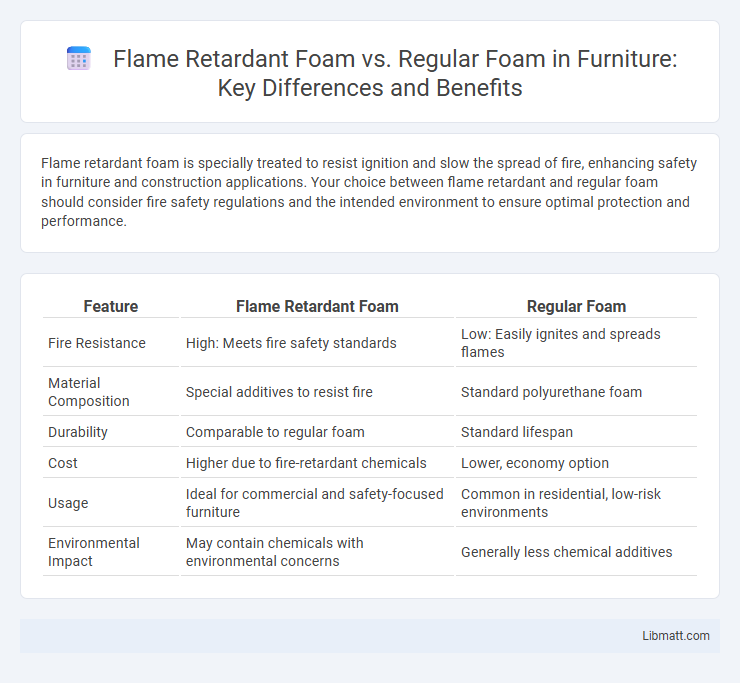Flame retardant foam is specially treated to resist ignition and slow the spread of fire, enhancing safety in furniture and construction applications. Your choice between flame retardant and regular foam should consider fire safety regulations and the intended environment to ensure optimal protection and performance.
Table of Comparison
| Feature | Flame Retardant Foam | Regular Foam |
|---|---|---|
| Fire Resistance | High: Meets fire safety standards | Low: Easily ignites and spreads flames |
| Material Composition | Special additives to resist fire | Standard polyurethane foam |
| Durability | Comparable to regular foam | Standard lifespan |
| Cost | Higher due to fire-retardant chemicals | Lower, economy option |
| Usage | Ideal for commercial and safety-focused furniture | Common in residential, low-risk environments |
| Environmental Impact | May contain chemicals with environmental concerns | Generally less chemical additives |
Introduction to Foam Types
Flame retardant foam contains chemical additives that inhibit or resist the spread of fire, making it essential for safety in furniture, mattresses, and insulation. Regular foam, typically made from polyurethane, lacks these fire-resistant properties and is more prone to combustion. Choosing flame retardant foam enhances compliance with fire safety standards and reduces the risk of fire-related hazards.
What Is Regular Foam?
Regular foam is a versatile, lightweight material commonly used in furniture, bedding, and insulation due to its cushioning and supportive properties. It is made from polyurethane or other synthetic polymers, offering comfort and flexibility but lacking inherent flame-resistant qualities. Your choice between regular foam and flame retardant foam impacts safety standards, especially in applications requiring compliance with fire safety regulations.
What Is Flame Retardant Foam?
Flame retardant foam is specially formulated with chemical additives that inhibit or resist the spread of fire, enhancing safety in various applications such as furniture, bedding, and automotive interiors. Unlike regular foam, which ignites and burns quickly, flame retardant foam slows down combustion and reduces the release of toxic fumes, improving overall fire safety compliance. These fire-resistant properties make flame retardant foam a preferred choice in environments where fire hazards are a significant concern.
Key Differences Between Flame Retardant and Regular Foam
Flame retardant foam is treated with chemical additives that significantly reduce its flammability, enhancing safety in environments prone to fire hazards, unlike regular foam which lacks these protective properties. Its improved fire resistance complies with safety regulations and standards crucial for upholstery, bedding, and insulation applications. Choosing flame retardant foam ensures your products meet safety codes and provide better protection against ignition and flame spread.
Fire Safety Standards and Regulations
Flame retardant foam complies with strict fire safety standards and regulations such as ASTM E84 and California Technical Bulletin 117, designed to reduce flammability and slow fire spread. Regular foam typically lacks these certifications, making it less effective at resisting ignition and providing critical escape time during fires. Choosing flame retardant foam enhances your overall safety by meeting regulatory requirements and improving fire performance in residential and commercial settings.
Common Applications of Regular Foam
Regular foam is commonly used in furniture cushions, mattresses, and packaging materials due to its comfort and cushioning properties. It is widely applied in automotive seating, bedding products, and soundproofing panels for homes and offices. Your choice of regular foam can enhance everyday comfort but may lack the fire resistance required in high-risk environments.
Typical Uses for Flame Retardant Foam
Flame retardant foam is commonly used in commercial furniture, automotive seating, and public transportation to meet strict fire safety regulations. This foam enhances protection by slowing down ignition and reducing the spread of flames, making it ideal for environments with high fire risk. You can rely on flame retardant foam in applications where compliance with safety standards is essential to protect both people and property.
Pros and Cons: Flame Retardant vs. Regular Foam
Flame retardant foam offers enhanced fire resistance, reducing the risk of ignition and slowing flame spread, which is crucial for meeting safety standards in furniture and construction industries. However, it often contains chemical additives that may impact indoor air quality and carry potential health concerns, alongside a higher cost compared to regular foam. Regular foam provides comfort and affordability but lacks fire-resistant properties, increasing fire hazards and limiting its use in applications requiring stringent fire safety compliance.
Health and Environmental Considerations
Flame retardant foam often contains chemical additives such as polybrominated diphenyl ethers (PBDEs) that can off-gas toxic compounds, posing potential health risks including respiratory issues and hormone disruption. Regular foam, typically free from these flame retardant chemicals, tends to have a lower toxicity profile but may be more flammable, raising safety concerns in fire scenarios. Environmentally, flame retardant foams are less sustainable due to persistent chemical residues and challenges in recycling, whereas regular foam offers better biodegradability and less ecological impact over its lifecycle.
Choosing the Right Foam for Your Needs
Flame retardant foam offers enhanced safety by inhibiting the spread of fire, making it ideal for environments with strict fire safety regulations such as commercial buildings, theaters, and public spaces. Regular foam, while often more cost-effective and providing good cushioning, lacks the chemical treatments that slow combustion and may not meet certain fire safety standards. Selecting the right foam depends on balancing safety requirements, budget constraints, and the specific application in furniture, insulation, or automotive uses.
flame retardant foam vs regular foam Infographic

 libmatt.com
libmatt.com